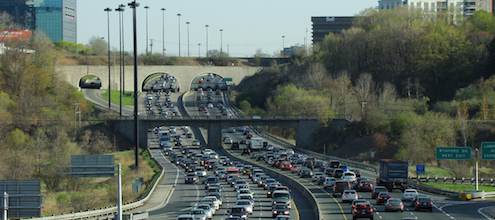
Traffic, and its Solution, is All About People
By Kevin Vuong
On November 3rd, I joined a panel of experts in Toronto to talk about Pricing Congestion in the GTHA. If there is one take away from that discussion, it’s this: the success of congestion pricing hinges on widespread public understanding and acceptance.
As individuals engaging in this discussion at the local level, we need to do a much better job communicating what HOT (high-occupancy toll) lanes are all about, how they work, and why they help commuters—drivers, public transit goers, cyclists, and pedestrians alike.
For economists, it’s a slam-dunk. For policy wonks, it’s such an obvious decision—it’s hard to understand why we don’t already have a system in place.
But these are not the folks we need to convince.
We need buy-in from people in our communities who suffer the most from congestion and stand to benefit the most from less of it.
Seeing Beyond the Numbers
The Ecofiscal Commission’s new report, We Can’t Get There From Here, focuses on the economic costs of congestion. That’s unsurprising given the authors are all economists. This information is certainly important and useful to policy makers. But, let’s face it, this not the first time (nor will it be the last) that we hear about the billions upon billions of dollars that gridlock costs us.
These figures are simply too big and abstract for many of us to comprehend. For example, the annual health costs of congestion are estimated to be as high as $7 billion. How many of us can visually picture a billion of something? Never mind imagining what 7 billion of something would look like.
The big picture numbers are sobering, but obscure the individual realities—the child who suffers from asthma because of all the tailpipe emissions she breathes just while playing outside her home.
The most important point: these numbers have been insufficient in advancing any sort of solution to the age-old problem of congestion. We need to start seeing beyond them, and talking to people about the impacts of traffic congestion on their own lives and what they stand to gain from pricing it.
Real People Need Real Congestion Solutions
Real stories about the benefits of congestion pricing should include the experience of single mothers like Mathilda who works two jobs to put food on the table for her family. She’s at risk of losing that second job because she cannot get to work on time. Traffic is literally a barrier to her livelihood. Would HOT lanes, which speed up traffic across entire highways and get busses running faster too, make a difference to Mathilda? I think they would.
What about Nathan? We need to explain how HOT lanes will help him get to daycare on time to pick up his son and avoid the late penalty that his family can ill afford.
And Joe the contractor, he needs to recognize that the time he saves from having to sit in traffic could mean taking on another two or three renovation jobs that he otherwise would have forfeited.
These are actual people. Their time matters to them. And we need their genuine support for congestion pricing because in its absence there will be little to no political will to implement it.
A New Road Forward
The concept of congestion pricing is not new, nor is congestion a new problem. But we need to forge a new road forward to ensure that we start moving towards a solution now. We don’t have to wait for more reports to tell us how bad this problem is nor can we afford to; we can and must start solving it today.
But that means communicating the consequences of not taking action in terms that everyday people can relate to. We need to humanize the costs of congestion and we also need to humanize the solutions.
Congestion pricing is just one part of a more comprehensive system to get our cities and our people moving. HOT lanes in the GTHA could set the stage for a future with holistic mobility solutions that are necessary to broader equity and employment challenges. But first we must build the foundation for that possibility. So let’s take the lessons of congestion pricing off the page and into the real lives of people who, more than anything, need to move forward.




Comments are closed.